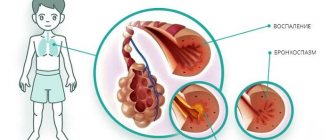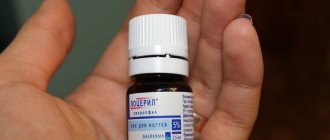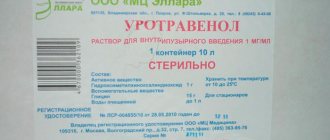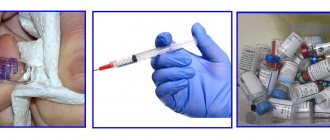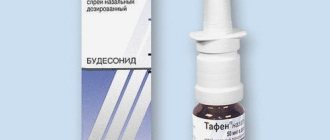Octagam is used as a prophylactic to strengthen the human immune system. The drug is a solution of human immunoglobulin and contains a wide range of antibodies to pathogens of various infectious diseases. Since the medicine is made from the blood and plasma of donors, the drug contains antibodies that are normally present in the body of a healthy person.
The immune system is responsible for human health, protecting it from diseases of microbes and viruses. Its main function is to promptly identify and eliminate any threats that threaten human life and health.
When problems arise with the immune system, immunodiagnostic methods are used to identify specific functional disorders and diagnose diseases, and develop immunocorrection.
Experienced immunologists from one of the leading clinics in the capital, the Yusupov Hospital, will help the patient learn how to do this correctly, diagnose and treat diseases associated with problems of the immune system.
Indications for use of the drug Octagam
The drug Octagam is prescribed for replacement and immunomodulatory therapy.
- hypogammaglobulinemia;
- congenital agammaglobulinemia;
- unclassified variable immunodeficiency;
- congenital HIV infection in children;
- Wiskott-Aldrich syndrome;
- severe combined immunodeficiency;
- multiple myeloma;
- chronic lymphocytic leukemia;
- idiopathic thrombocytopenic purpura in children and adults with a high risk of bleeding;
- before any surgical intervention;
- with Kawasaki disease, Guillain-Barre syndrome;
- during allogeneic bone marrow transplantation.
Side effects of the drug Octagam
Side effects when using Octagam may be as follows:
- headache;
- chills;
- fever;
- vomiting, nausea;
- joint pain;
- moderate lower back pain.
Side effects usually depend on the incorrect dose of the drug and the rate of administration.
When treating with drugs made from donor blood or plasma, the possibility of infectious diseases cannot be completely excluded. Unfortunately, we cannot ignore the emergence of new viruses and infectious agents of unknown breed, as well as other pathogens.
Instructions for use of OCTAGAM® (OCTAGAM)
The drug contains 100 mg of maltose per 1 ml as an excipient. Maltose interference in blood glucose tests may result in elevated glucose values and therefore inappropriate insulin administration, which can lead to life-threatening hypoglycemia and death. In addition, cases of true hypoglycemia may go untreated if the hypoglycemic state is masked by an elevated glucose value.
Octagam® 5% contains maltose, a disaccharide obtained from cereals. Anaphylactoid/anaphylactic reactions have been reported in association with the infusion of other maltose/corn starch related products. Patients allergic to cereals should either avoid the use of Octagam® 5% or be closely monitored for signs and symptoms of acute hypersensitivity reactions.
The occurrence of some severe side effects may be related to the rate at which the drug is administered. The recommended rate of administration must be strictly observed. During drug administration, the patient's condition and the occurrence of any symptoms should be monitored throughout the entire period of drug administration.
The most common adverse reactions that may occur are:
- at a high rate of administration;
- when administering immunoglobulin for the first time or, in rare cases, when switching to another immunoglobulin or after a long time has passed since the last infusion.
Potential complications can be avoided by ensuring that patients:
- are not sensitive to normal human immunoglobulin, for which purpose the drug is administered slowly, at a rate of 1 ml/kg/h;
- Monitored closely by staff for any symptoms throughout the infusion period. This is especially true for patients who have not previously received immunoglobulin preparations; patients who previously received normal human immunoglobulin from another manufacturer and switched to the administration of the drug Octagam® 5%; as well as those patients who have a long break after the last immunoglobulin infusion. Such patients require constant monitoring throughout the entire period of the first infusion, as well as for 1 hour after its completion. Other patients should be observed for at least the first 20 minutes of infusion.
If an undesirable side effect occurs, the rate of drug administration should be reduced or the infusion should be stopped. The treatment needed depends on the nature and severity of the adverse reaction.
In case of shock, standard anti-shock medical treatment should be applied.
When using immunoglobulins for intravenous administration in all patients, the following is required:
- providing adequate hydration before starting the infusion;
- diuresis control;
- control of serum creatinine levels;
- avoid concomitant use of loop diuretics.
Octagam® 5% contains no more than 0.015 mmol (or 0.35 mg) sodium per 1 ml. This should be taken into account in patients on a controlled sodium diet.
Hypersensitivity
True hypersensitivity reactions are rare. They can occur in patients with antibodies to IgA.
IVIG is not indicated for patients with selective IgA deficiency, when IgA deficiency is the only disorder.
In rare cases, the use of human normal immunoglobulin can cause a sharp decrease in blood pressure with an anaphylactic reaction, even in patients who have tolerated previous treatment with human normal immunoglobulin.
Thromboembolism
There is clinical evidence that the administration of immunoglobulin in high doses can lead to an increase in the viscosity of the blood plasma in patients at risk, which increases the risk of ischemia and thromboembolic complications such as myocardial infarction, stroke, pulmonary embolism and deep vein thrombosis, which, as believed to be associated with a relative increase in blood viscosity due to the intake of large amounts of immunoglobulin. Caution should be exercised when prescribing and administering Octagama® 5% to patients with obesity and pre-existing risk factors for thrombosis (for example, advanced age, hypertension, diabetes mellitus, history of vascular disease or thrombotic complications, acquired or hereditary thrombophilic disorders, prolonged immobilization, severe hypovolemia, diseases that increase blood viscosity).
In patients at risk of thromboembolic adverse reactions, IVIG drugs should be used at the minimum infusion rate and dose possible.
Acute renal failure
Cases of acute renal failure have been reported in patients receiving IVIG therapy. In most cases, risk factors have been established (eg, pre-existing renal failure, diabetes mellitus, age over 65 years, hypovolemia, excess weight, or concomitant use of nephrotoxic drugs).
In case of renal failure, discontinuation of IVIG should be considered. Although in these reports, renal dysfunction and acute renal failure were associated with the use of many of the licensed IVIG products containing sucrose, glucose, and maltose as excipients, products containing sucrose accounted for a disproportionately large proportion of the total. In patients at risk, the use of IVIG products that do not contain sucrose should be considered. Octagam® 5% contains maltose.
In patients at risk for adverse reactions of acute renal failure, IVIG drugs should be used at the minimum infusion rate and the lowest possible dose.
Aseptic meningitis syndrome (ASM)
Aseptic meningitis syndrome has been reported in association with IVIG treatment. Discontinuation of IVIG treatment resulted in remission of MAS within a few days without complications. The syndrome usually occurs within a few hours to 2 days after IVIG treatment. In the cerebrospinal fluid, pleocytosis of up to several thousand cells per mm3, predominantly of the granulocytic series, and an increase in protein content up to several hundred mg/dl are often observed.
More often, SAM may occur in association with a high dose (2 g/kg) of IVIG.
Hemolytic anemia
IVIG products may contain blood group antibodies that can act as hemolysins and cause in vivo coating of red blood cells with immunoglobulin, leading to a positive direct antiglobulin reaction (Coombs test) and, less commonly, hemolysis. Hemolytic anemia may develop after IVIG treatment due to increased red blood cell sequestration. IVIG recipients should be monitored for clinical signs and symptoms of hemolysis. The content of anti A- and anti B-hemmaglutinins is <64 in Octagam® 5%.
Impact on serological test results
After administration of immunoglobulin, a transient increase in various passively transferred antibodies in the patient's blood can lead to false-positive results of serological tests.
Passive transfer of antibodies to red blood cell antigens (eg, A, B, or D) may alter the results of some red blood cell antibody serologic tests (eg, DAT, direct Coombs test).
Infectious agents
Standard measures aimed at preventing infections resulting from the use of medicinal products prepared from human blood or plasma include selecting healthy donors, testing each portion of plasma and plasma pools for the presence of specific markers of infection; and incorporating effective virus removal/inactivation procedures into the manufacturing process, including solvent-detergent viral inactivation and pH 4.0 incubation. Despite this, when using drugs made from human blood or plasma, the possibility of contracting infectious diseases cannot be completely excluded. This also applies to infectious agents of unknown origin or new viruses and other pathogens.
These measures are considered effective for enveloped viruses such as HIV, HBV (hepatitis B virus) and HCV (hepatitis C virus).
The effectiveness of measures may be limited against non-enveloped viruses such as HAV (hepatitis A virus) and parvovirus B19.
There is encouraging clinical experience indicating that there is no risk of transmission of infectious pathogens hepatitis A and parvovirus B19 when administered immunoglobulins. It is also assumed that antibody content contributes significantly to viral safety.
Whenever Octagam® 5% is administered to a patient, it is strongly recommended to register the name of the drug and the batch number of the drug in order, if necessary, to establish a connection between the patient’s condition and the use of a specific batch of the drug.
Acute post-transfusion lung injury (TRALI)
There have been reports of non-cardiogenic pulmonary edema [Transfusion Acute Lung Injury (TRALI)] in patients receiving IVIG therapy, so this side effect cannot be completely excluded for Octagam 5%, but no cases have been found with the drug to date Octagam® 5%. TRALI is characterized by severe respiratory distress, pulmonary edema, hypoxemia, normal left ventricular function, fever, and usually occurs within 1 to 6 hours after transfusion.
(False) increased erythrocyte sedimentation rate
In patients receiving IVIG therapy, the erythrocyte sedimentation rate (ESR) may be falsely elevated (non-inflammatory increase).
Volume overload
Volume overload can occur when the volume of IVIG (or any other blood or plasma-derived product) administered and other accidental infusions cause hypervolemia and acute pulmonary edema.
Local reactions at the injection site
Local reactions at the injection site have been identified and may include bruising, injection site erythema, injection site itching, and similar symptoms.
Use in pediatrics
There are no specific or additional warnings or precautions for use in pediatric patients.
Special handling precautions
The drug should not be warmed to room temperature or body temperature before use.
The solution should be clear or slightly opalescent, colorless or slightly yellow.
Solutions that are cloudy or contain inclusions should not be used.
Due to the possibility of bacterial contamination, any remaining contents should be discarded.
Any unused product or waste material should be disposed of in accordance with local regulations.
Impact on the ability to drive vehicles and operate machinery
The ability to drive vehicles and operate machinery may be reduced as a result of some adverse reactions associated with Octagam® 5%. Patients who experience adverse reactions during treatment should wait until they resolve before driving or operating machinery.
Contraindications and caution when using the drug Octagam
The drug Octagam is contraindicated in case of individual sensitivity to human immunoglobulins or to any of the components of the drug.
Doctors recognize the drug Octagam as quite safe, but use it with caution in elderly people and obese patients. Also, special attention should be paid to patients suffering from diabetes, arterial hypertension, and diseases of the vascular system. Patients who are immobile for a long time should also use this drug under strict medical supervision. Before prescribing the drug, the specialist must discuss with the patient all the benefits and risks of Octagam therapy.
Symptoms of herpes in children
The symptoms of herpes in children are very similar to those in adults, but most often they are much more pronounced. Much here depends on the age at which the child became infected.
When a child is infected in the first days or even hours after birth, they usually talk about neonatal herpes , characterized by a special symptomatic picture and specific course.
In children of a later age, the symptoms of herpes manifest themselves somewhat differently. So, at the first, prodromal stage, it is not always possible to understand that the child is developing herpes. At this time, the child becomes less mobile, his temperature rises, he experiences severe malaise and weakness. Often at this stage headaches and sore throat appear, which are a sign of herpangina. It’s easy to mistake such symptoms for a cold and start fighting the wrong infection.
At the next stage, red itchy rashes appear on and around the lips, in the mouth, and sometimes around the eyes. As their intensity increases, the strength of the itching increases, which then turns into pain.
Next, transparent blisters filled with colorless liquid appear on the rash. In appearance, they are identical to the same vesicular rashes in adults, but are located over a larger area and can be much more pronounced. When a child develops herpes gingivitis and stomatitis, blisters appear not only on the outer skin, but also in the oral cavity - on the mucous membranes, tonsils, tongue and gums. At the same time, on the gums they look like small white dots, no less painful than vesicles in other places.
Over time, these blisters become opaque and the fluid in them begins to resemble pus. All this time, the child is worried about severe pain, and with herpes sore throat, there are problems with swallowing food. Young children with severe herpes may scream a lot and sleep very poorly.
At the next stage, the bubbles burst, liquid flows out of them, in which viral particles are teeming, there are literally billions of them, and in place of each bubble a small ulcer appears. It quickly becomes crusty and in this form stops bothering the child.
The last stage is the healing stage. The skin at the site of the ulcers is restored, the scabs fall off and no traces of herpes remain.
Neonatal herpes is characterized by approximately the same symptoms, which, however, also has its own specifics.
Treatment of cytomegalovirus during pregnancy: Octagam
Cytomegalovirus, or CMV for short, is a virus that is widespread throughout the world. Just like other viruses (herpes, rubella, toxoplasma and other infections), cytomegalovirus during pregnancy can cause congenital diseases in the fetus.
When planning a pregnancy, doctors advise patients to undergo a test for antibodies to cytomegalovirus.
Analysis options may be as follows:
- IgG antibodies to cytomegalovirus (negative);
- IgM antibodies to cytomegalovirus (negative).
Such test results mean that the body does not have immunity to the virus. Doctors believe that there is no point in postponing pregnancy planning, but during pregnancy you need to be very careful and avoid contact with people suffering from cytomegalovirus.
Only a specialized specialist can prescribe the correct treatment for cytomegalovirus during pregnancy. Octagam can be prescribed for use according to the doctor’s recommendations, based on the health status of the mother and fetus.
The same applies to the frequently asked question - is it possible to take Octagam before cryotransfer? You should not look for answers on various forums and websites. The cryotransfer process is a complex of complex measures, including preparation for implantation of embryos after their transfer under ultrasound guidance and drug support after implantation into the patient’s body.
The body of expectant mothers needs to increase the level of antibodies in the blood. The drug Octagam, thanks to its active ingredient, can help achieve positive results with IVF. However, we should not forget that Octagam is not a vitamin, it is a medical product. And you need to approach its use very carefully. In individual cases, according to the instructions and recommendations of a specialized specialist, patients may be prescribed a course of taking Octagam.
pharmachologic effect
Octagam contains mainly class G immunoglobulins - antibodies to pathogens of various infections. The distribution of immunoglobulin G (IgG) subclasses in the preparation is the same as in natural plasma and has all the properties characteristic of a healthy person. Effective doses of the drug can restore low IgG levels to their normal levels. IgG molecules do not undergo changes due to chemical or enzymatic action. Antibody activity is completely preserved.
Octagam contains no more than 3% polymers, the content of monomers and dimers is no less than 90%.
